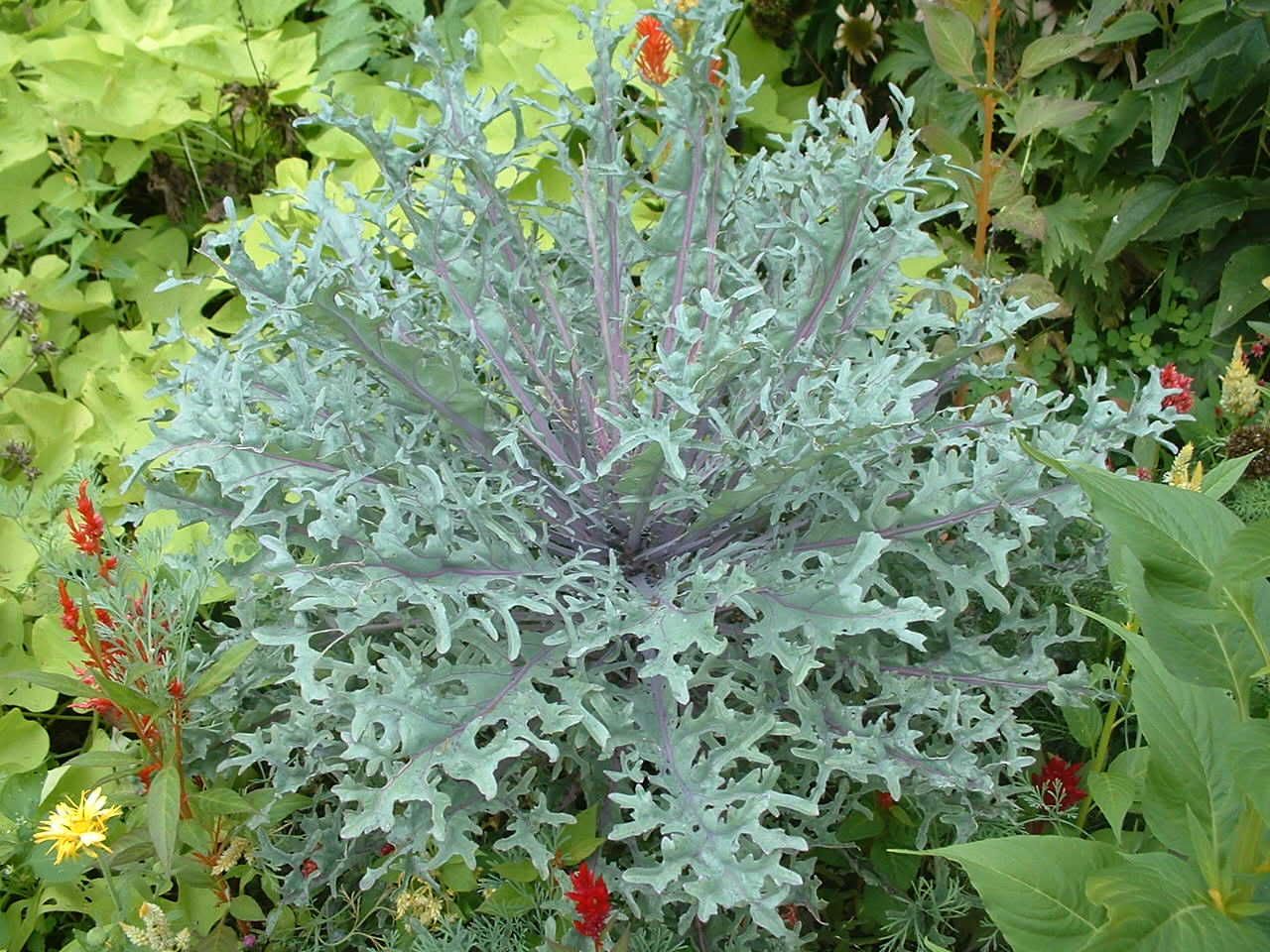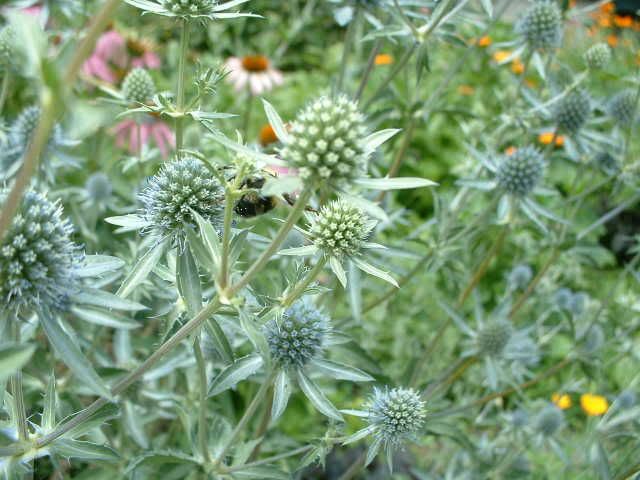

 I was thinking tonight about how there are few things left in the garden that haven't bloomed yet this summer ... yes, the toad lilies are yet to spring into flower, but they're the pleasantly rare exception at this point in the season, which is what makes them such a valuable addition to the shade garden. More on those when they start blooming, so be patient ....
I was thinking tonight about how there are few things left in the garden that haven't bloomed yet this summer ... yes, the toad lilies are yet to spring into flower, but they're the pleasantly rare exception at this point in the season, which is what makes them such a valuable addition to the shade garden. More on those when they start blooming, so be patient ....Well, all that pondering led me to do a big old "D'OH!" when it occurred to me that there are many largely under-appreciated plants we put in the garden, just for purposes of adding texture to the overall design. Of course, there are the usual architectural or purely textural plants one might consider .... such as ornamental grasses (Miscanthus "Porcupine Grass" and Festuca Glauca "Blue Fescue" come to mind immediately), but there are a host of other ornamentals that deserve the spotlight for their valuable contributions to the perennial garden. So let's take a look at three tonight, each with its own particular virtues which recommend them to the well-rounded (well, at least we like to think so!) perennial border.
First up is Flowering Kale, a member of the Brassica or cabbage family of plants. Though we haven't planted these often in the past few years, they are wonderful examples who really excel in the late summer months right up until frost. They blend their familiar shade of cabbage-y grey with delicate shades of purple throughout to introduce a most welcome cooler hue into the garden when other plants have bloomed and gone ... and as the weather cools down with the arrival of fall, they truly spring into intense color which lasts as long as temperatures stay above freezing. Once frost arrives, they may linger a bit longer, ramping up their colors briefly before they melt into a rather unattractive pile of goo. The one pictured here is a new one we found this year called Red Peacock, and if the picture on the stake is accurate, we can still expect an intense flush of scarlet to appear in the center of the plant later this fall.
Though Kale is generally just considered an ornamental garden plant, it is indeed edible, as are most (if not all) of the Brassicas (which of course include all the cabbages, broccolis and brussel sprouts). But as a specimen plant, it definitely deserves a place of honor in the garden, somewhere it can shine before all is said and done when the freezes come in late fall. They are easy to grow, don't seem to have any obvious pests and require little attention other than being placed in a very sunny spot, watered occasionally and left to their own designs. You can also see, in the background of this shot, some of the Celosia sports (more forthcoming, I promise!) as well as the chartreuse version of Sweet Potato Vine (Ipomoea battata), which has really come into its own the last few weeks.
The second picture is Silver Mound, a member of the Artemisia (Wormwood) family. I can't begin to praise this humble --and rather common-- textural perennial enough. As if any garden didn't deserve several specimens of Artemisia species, this one is the absolute must have in my opinion. It has a wonderful mounding growth habit that makes it perfect for filling in tough spots in the garden (such as at the base of the boulders in the front garden here). It also just plain feels delightful to the touch ... with its light and feathery grey-green foliage ... and it has a very pleasant herby fragrance to it as well, as do most of the Artemisias. (Yes, that's the family of plants who give us Artemisia absinthium, producer of the forbidden ingredient of Absinthe, that extracted substance known as Thujol.) Silver Mound, despite its common origins is an excellent choice for sunny spots with poorish soil, because it thrives on neglect for the most part and is quite happy to stake out its spot, adding yet another cooler hue to the summer garden ....
And finally, we have one of my favorite discoveries of the last ten years or so, Sea Holly (Eryngium maritimum). I couldn't write this post without including at least one shot of this most unusual of plants ... something that deserves more exposure in the perennial garden! Though it looks rather spiny and prickly, it is anything but painful to touch ... in fact, the bracts composing the blooms of this plant are really rather pleasant to the touch. If you look closely at this shot, you'll see a bumblebee hard at work ... and that's one of the more interesting aspects of Sea Holly, namely that it attracts a host of beneficial bees and wasps with its thistle-like blooms. These are the kinds of insects you want in your garden, as they prey on more destructive pests who would like to lay waste to your vegetables and other flowers. And the ethereal hazy gun-metal blue of the blooms at their maturity brings a unique hue to the garden in mid-summer (this picture was taken in July). They're tough plants that self-seed generously (we always have plenty to give away come spring), grow well in any sunny spot (though sometimes they need a bit of staking when they bloom profligately, as ours did this year). Given a prominent spot toward the front of the border, they always prompt questions as to what they are, and most people tend to assume it's some sort of thistle run amok, though that could hardly be further from the truth .... At some point I plan on highlighting this beauty in more detail, but for now, I had to include it in this grouping of plants that qualify as worthy textural garden elements.
As those who know me can attest, for the most part I'm all about the flowers, but even the most bloom-obsessed among us do need to step back at times and contemplate the quiet beauty that less "flashy" plants can offer us in the overall scheme of the garden ... precisely why I ended up at this point tonight in my garden musings ... yes, there's more flash to come, but at this point in the waning summer days, I felt compelled to give these guys a shout out of their own.







4 comments:
Geeze and I didn't even toe tap. I guess Olivia got pushy. :)
Wonderful post IVG. Being the novice in plants that I am, I go more for the put them in the ground and don't worry about them. Fully grown trees come to mind.
Try to take it easy at work and slack when possible.
Good morning!
Wow ... you're spoiling us this week IVG! :)
This is a great post to highlight the textural aspects that plants add to the garden. And you've shown us three very different examples ... I really like the sea holly and I remember when you first mentioned it in a cafe one night. And LOL at the "pile of goo" comment ... I hope that you will be able to capture that kale when it turns red ... those feathery leaves would look amazing in that colour!
Good point. One can't truly be "all about the flowers" (or veggies) to have a well-balanced garden.
just dropping by to say hi
Post a Comment